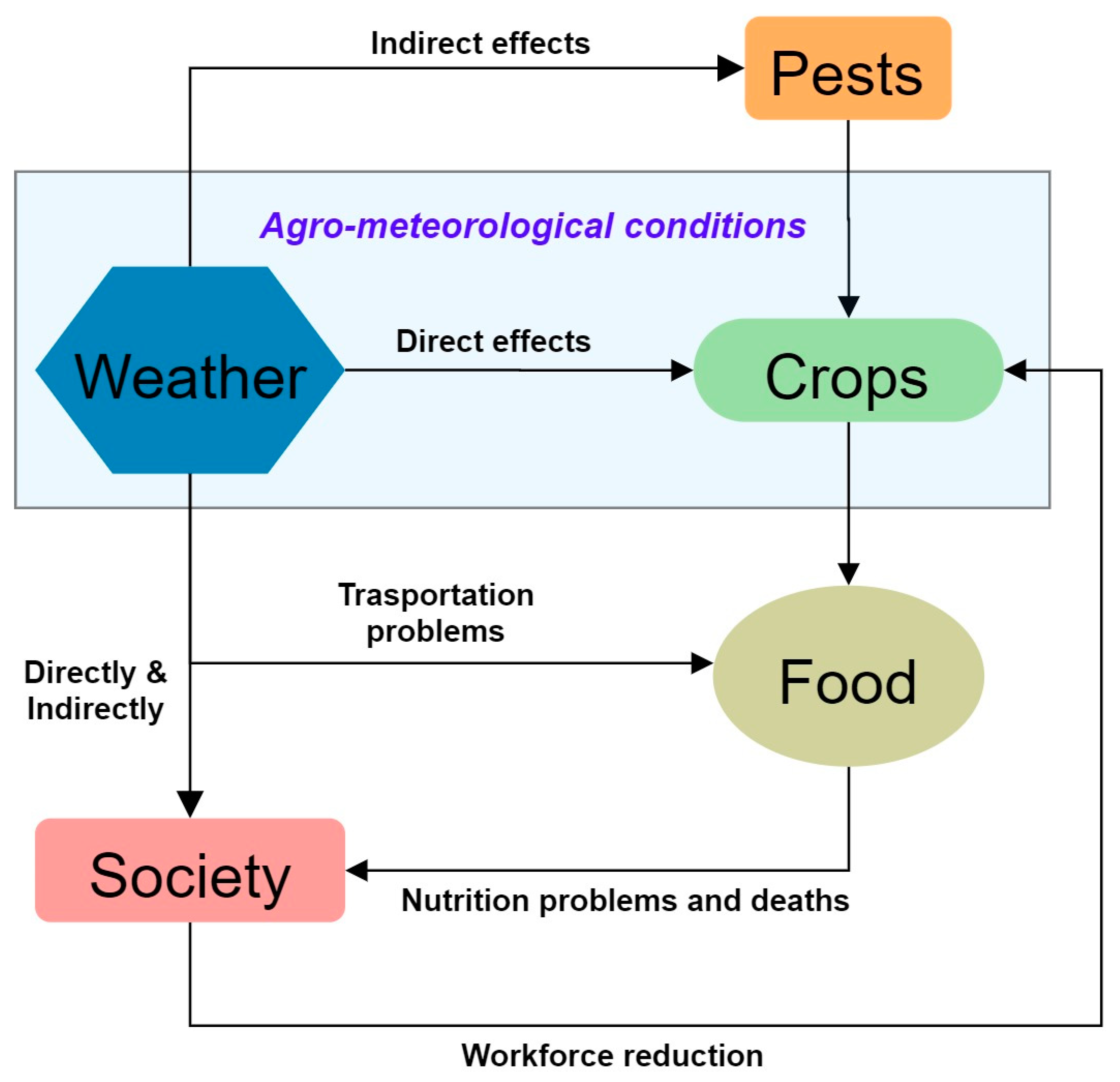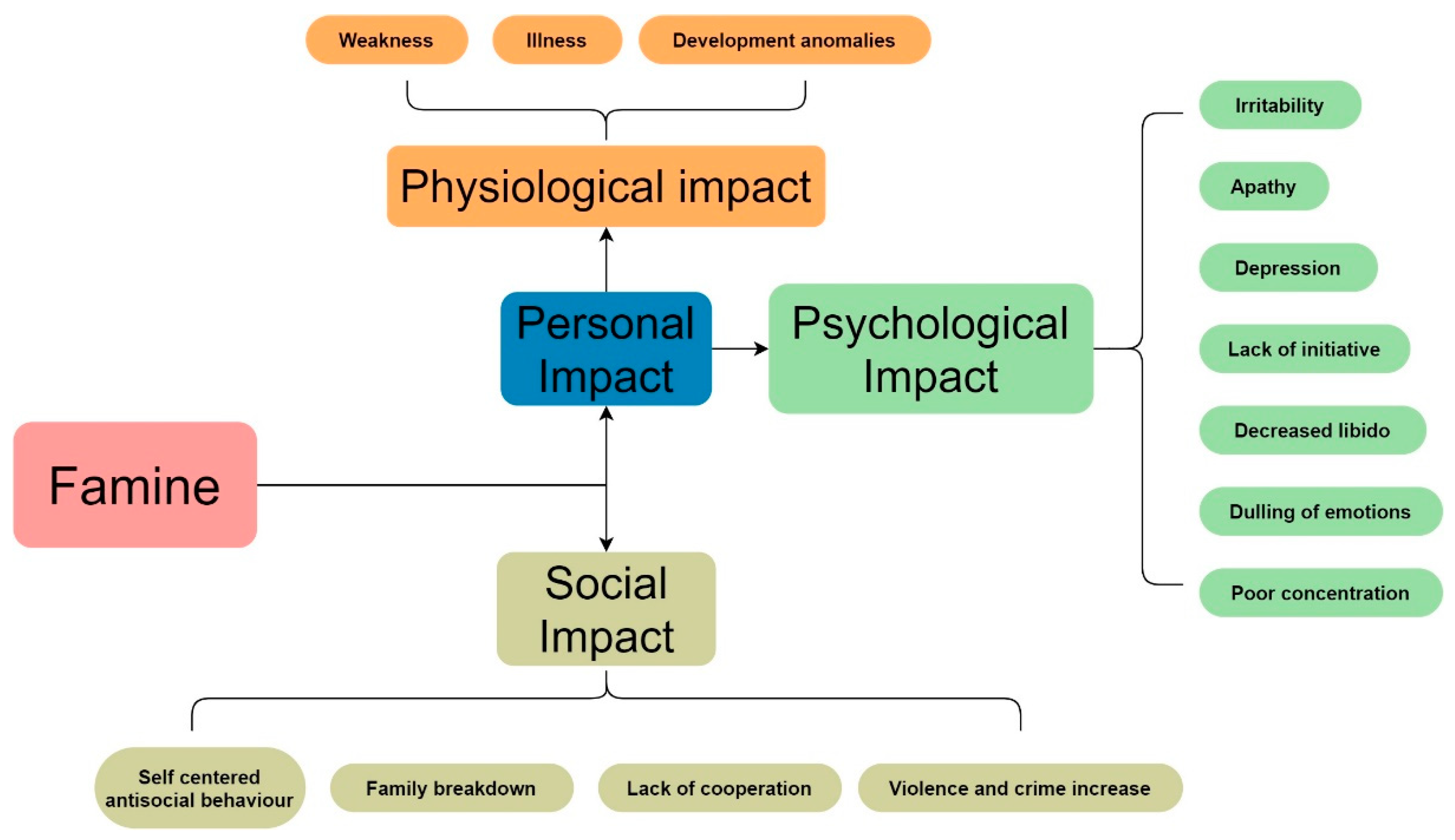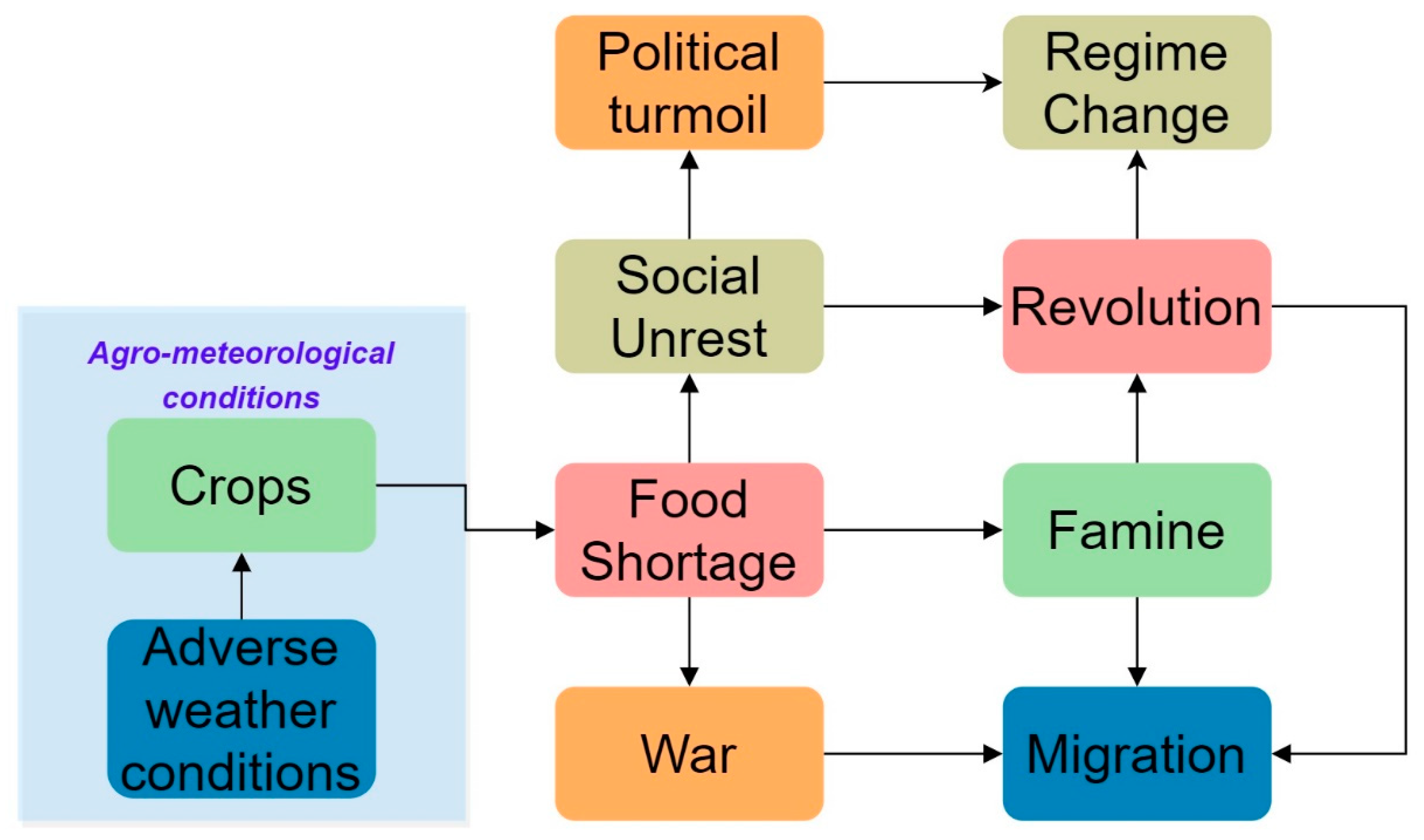The Agro-Meteorological Caused Famines as an Evolutionary Factor in the Formation of Civilisation and History: Representative Cases in Europe
Abstract
:1. Introduction
2. The Agro-Meteorological Conditions as a Civilisation’s Driving Force
2.1. The Agro-Meteorological Conditions in the Famine Mechanism
2.2. The Agro-Meteorological Famine (AMF) and Society
2.3. Agro-Meteorological Conditions and the Societal Chain Reaction
3. Selected Agro-Meteorological Famine Incidents in European History
3.1. The “Great Famine” of 1315 AD
3.2. The Northern European Famine (1693–97 AD)
3.3. Agro-Meteorological Conditions and the French Revolution
3.4. Agro-Meteorological Conditions and the Two Irish Historical Famines
4. Summary and Future Perspectives
Author Contributions
Funding
Institutional Review Board Statement
Informed Consent Statement
Data Availability Statement
Conflicts of Interest
References
- Diamond, J. Guns, Germs, and Steel: The Fates of Human Societies; WW Norton & Company: New York, NY, USA, 1999; ISBN 0-393-06922-2. [Google Scholar]
- Harari, Y.N. Sapiens: A Brief History of Humankind, 1st ed.; Harper: New York, NY, USA, 2015; ISBN 978-0-06-231609-7. [Google Scholar]
- Fraser, E.D.G. Can economic, land use and climatic stresses lead to famine, disease, warfare and death? Using Europe’s calamitous 14th century as a parable for the modern age. Ecol. Econ. 2011, 70, 1269–1279. [Google Scholar] [CrossRef]
- Hoogenboom, G. Contribution of agrometeorology to the simulation of crop production and its applications. Agric. For. Meteorol. 2000, 103, 137–157. [Google Scholar] [CrossRef]
- Weiss, A.; van Crowder, L.; Bernardi, M. Communicating agrometeorological information to farming communities. Agric. For. Meteorol. 2000, 103, 185–196. [Google Scholar] [CrossRef]
- Gouache, D.; Bouchon, A.-S.; Jouanneau, E.; Le Bris, X. Agrometeorological analysis and prediction of wheat yield at the departmental level in France. Agric. For. Meteorol. 2015, 209–210, 1–10. [Google Scholar] [CrossRef]
- Fagan, B. The Long Summer. How Climate Changed Civilization; Granda Books: London, UK, 2004. [Google Scholar]
- Gornitz, V. Encyclopedia of Paleoclimatology and Ancient Environment; Springer: New York, NY, USA, 2009. [Google Scholar]
- Lamb, H. Climate, History and the Modern World; Routledge: London, UK, 1997. [Google Scholar]
- Kracauer-Hartig, E.; Grozev, O.; Rosenzweig, C. Climate change, agriculture and wetlands in eastern Europe: Vulnerability, adaptation and policy. Clim. Chang. 1997, 36, 107–121. [Google Scholar] [CrossRef]
- Behringer, W. Weather, hunger and fear: Origins of the European witch hunts in climate, society and mentality. Ger. Hist. 1995, 13, 1–27. [Google Scholar] [CrossRef]
- Ellman, M. The role of leadership perceptions and of intent in the soviet famine of 1931–1934. Eur. Asia Stud. 2005, 57, 823–841. [Google Scholar] [CrossRef]
- Grove, R.H. The Great El Niño of 1789–93 and its global consequences: Reconstructing an extreme climate event in world environmental history. Mediev. Hist. J. 2006, 10, 75–98. [Google Scholar] [CrossRef]
- Huhtamaa, H. Climatic anomalies, food systems, and subsistence crises in medieval Novgorod and Ladoga. Scand. J. Hist. 2015, 40, 562–590. [Google Scholar] [CrossRef] [Green Version]
- Pfister, C. Climatic extremes, recurrent crises and witch hunts: Strategies of european societies in coping with exogenous shocks in the late sixteenth and early seventeenth centuries. Mediev. Hist. J. 2006, 10, 33–73. [Google Scholar] [CrossRef]
- Wheatcroft, S.G. The soviet famine of 1946–1947, the weather and human agency in historical perspective. Eur. Asia Stud. 2012, 64, 987–1005. [Google Scholar] [CrossRef]
- Fagan, B.M. Floods, Famines, and Emperors: El Niño and the Fate of Civilizations, 2nd ed.; Basic Books: New York, NY, USA, 2009; ISBN 0-465-01121-7. [Google Scholar]
- Jordan, W.C. The Great Famine: Northern Europe in the Early Fourteenth Century; Princeton University Press: Princeton, NJ, USA, 1997; ISBN 1-4008-2213-0. [Google Scholar]
- Slavin, P. Market failure during The Great Famine in England and Wales (1315–1317). Past Present 2014, 222, 9–49. [Google Scholar] [CrossRef]
- Slavin, P. Climate and famines: A historical reassessment. WIREs Clim. Chang. 2016, 7, 433–447. [Google Scholar] [CrossRef]
- Engler, S. Developing a historically based “famine vulnerability analysis model” (FVAM)–An interdisciplinary approach. Erdkunde 2012, 66, 157–172. [Google Scholar] [CrossRef]
- Alfani, G.; Ó Gráda, C. The timing and causes of famines in Europe. Nat. Sustain. 2018, 1, 283–288. [Google Scholar] [CrossRef]
- Jantunen, J.; Ruosteenoja, K. Weather conditions in northern Europe in the exceptionally cold spring season of the famine year 1867. Geophysica 2000, 36, 69–84. [Google Scholar]
- Nafziger, E.W.; Auvinen, J. The failure of agriculture: Food entitlements, élite violence, and famines. In Economic Development, Inequality and War: Humanitarian Emergencies in Developing Countries; Nafziger, E.W., Auvinen, J., Eds.; Palgrave Macmillan UK: London, UK, 2003; pp. 132–143. ISBN 978-1-4039-4376-7. [Google Scholar]
- Stathakopoulos, D.C. Famine and Pestilence in the Late Roman and Early Byzantine Empire: A Systematic Survey of Subsistence Crises and Epidemics; Routledge: London, UK, 2017; ISBN 978-1-315-25543-9. [Google Scholar]
- Vasey, D.E. Population, agriculture, and famine: Iceland, 1784–1785. Hum. Ecol. 1991, 19, 323–350. [Google Scholar] [CrossRef]
- Sharifi, A.; Pourmand, A.; Canuel, E.A.; Ferer-Tyler, E.; Peterson, L.C.; Aichner, B.; Feakins, S.J.; Daryaee, T.; Djamali, M.; Beni, A.N.; et al. Abrupt climate variability since the last deglaciation based on a high-resolution, multi-proxy peat record from NW Iran: The hand that rocked the cradle of civilization? Quat. Sci. Rev. 2015, 123, 215–230. [Google Scholar] [CrossRef] [Green Version]
- Tsonis, A.A.; Swanson, K.L.; Sugihara, G.; Tsonis, P.A. Climate change and the demise of Minoan civilization. Clim. Past 2010, 6, 525–530. [Google Scholar] [CrossRef] [Green Version]
- Haug, G.H.; Günther, D.; Peterson, L.C.; Sigman, D.M.; Hughen, K.A.; Aeschlimann, B. Climate and the collapse of Maya civilization. Science 2003, 299, 1731–1735. [Google Scholar] [CrossRef]
- McIntosh, R.J.; Tainter, J.A.; McIntosh, S.K. The Way the Wind Blows: Climate, History, and Human Action; Columbia University Press: New York, NY, USA, 2000; ISBN 0-231-11209-2. [Google Scholar]
- Norwine, J. A World After Climate Change and Culture-Shift; Springer: London, UK, 2013; ISBN 94-007-7352-8. [Google Scholar]
- O’Hare, G.; Sweeney, J.; Wilby, R. Weather, Climate and Climate Change: Human Perspectives; Routledge: Essex, UK, 2014; ISBN 1-317-90482-6. [Google Scholar]
- Berkhout, F.; Hertin, J.; Jordan, A. Socio-economic futures in climate change impact assessment: Using scenarios as “learning machines”. Glob. Environ. Chang. 2002, 12, 83–95. [Google Scholar] [CrossRef]
- Tol, R.S.J. The economic impacts of climate change. Rev. Environ. Econ. Policy 2018, 12, 4–25. [Google Scholar] [CrossRef] [Green Version]
- Philander, G. Encyclopedia of Global Climate and Climate Change; Sage: London, UK, 2008; Volumes 1–3. [Google Scholar]
- Telelis, I.G. Climatic fluctuations in the Eastern Mediterranean and the Middle East AD 300–1500 from Byzantine documentary and proxy physical paleoclimatic evidence—A comparison. Jahrbuch der Österreichischen Byzantinistik 2008, 58, 167–208. [Google Scholar] [CrossRef]
- Xoplaki, E.; Fleitmann, D.; Luterbacher, J.; Wagner, S.; Haldon, J.F.; Zorita, E.; Telelis, I.; Toreti, A.; Izdebski, A. The medieval climate anomaly and Byzantium: A review of the evidence on climatic fluctuations, economic performance and societal change. Quat. Sci. Rev. 2015. [Google Scholar] [CrossRef] [Green Version]
- Alcock, J.P. Food in the Ancient World; Greenwood Publishing Group: London, UK, 2006; ISBN 0-313-33003-4. [Google Scholar]
- Pilcher, J.M. Food in World History; Taylor & Francis: London, UK, 2017; ISBN 1-317-51451-3. [Google Scholar]
- Garnsey, P. Famine and Food Supply in the Graeco-Roman World: Responses to Risk and Crisis; Cambridge University Press: Cambridge, UK, 1988; ISBN 978-0-521-35198-0. [Google Scholar]
- Pribyl, K. Farming, Famine and Plague: The Impact of Climate in Late Medieval England; Springer International Publishing: Basel, Switzerland, 2017; ISBN 978-3-319-55952-0. [Google Scholar]
- Mavi, H.; Tupper, G. Agrometeorology. Principles and Applications of Climate Studies in Agriculture; Food Products Press: London, UK, 2004. [Google Scholar]
- Seemann, J.; Chirkov, Y.; Lomas, J.; Primault, B. Agrometeorology; Springer Science & Business Media: New York, NY, USA, 1979; ISBN 3-642-67288-4. [Google Scholar]
- Adams, J. Vegetation—Climate Interaction; Springer: Chichester, UK, 2007. [Google Scholar]
- Bourke, P.A. Emergence of Potato Blight, 1843–46. Nature 1964, 203, 805. [Google Scholar] [CrossRef]
- Kenny, G.J.; Harrison, P.A.; Parry, M.L. The Effect of Climate Change on Agricultural and Horticultural Potential in Europe; Environmental Change Unit, University of Oxford: Oxford, UK, 1993; ISBN 1-874370-02-8. [Google Scholar]
- Walter, J.; Schofield, R.; Appleby, A.B. Famine, Disease and the Social Order in Early Modern Society; Cambridge University Press: Cambridge, UK, 1991; Volume 10, ISBN 0-521-40613-7. [Google Scholar]
- Stigter, K. Applied Agrometeorology; Springer Science & Business Media: London, UK, 2010; ISBN 3-540-74698-6. [Google Scholar]
- Brown, N. History and Climate Change: A Eurocentric Perspective; Routledge: London, UK, 2005; ISBN 1-134-97759-X. [Google Scholar]
- Santoro, M.M. Regional Famine Patterns of the Last Millennium as Influenced by Aggregated Climate Teleconnections. Ph.D. Thesis, Arizona State University, Tempe, AZ, USA, August 2017. [Google Scholar]
- Chan, P.K.S.; Mok, H.Y.; Lee, T.C.; Chu, I.M.T.; Lam, W.-Y.; Sung, J.J.Y. Seasonal influenza activity in Hong Kong and its association with meteorological variations. J. Med. Virol. 2009, 81, 1797–1806. [Google Scholar] [CrossRef]
- Hahn, M.B.; Monaghan, A.J.; Hayden, M.H.; Eisen, R.J.; Delorey, M.J.; Lindsey, N.P.; Nasci, R.S.; Fischer, M. Meteorological conditions associated with increased incidence of West Nile virus disease in the United States, 2004–2012. Am. J. Trop. Med. Hyg. 2015, 92, 1013–1022. [Google Scholar] [CrossRef]
- Droulia, F.E.; Tsiros, I.X. The outdoor thermal climate conditions at a historical mountainous tuberculosis sanatorium site in Greece. Weather 2019, 74, 221–225. [Google Scholar] [CrossRef]
- Kalpazanov, Y.; Stamenova, M.; Kurchatova, G. Air pollution and the 1974–1975 influenza epidemic in Sofia: A statistical study. Environ. Res. 1976, 12, 1–8. [Google Scholar] [CrossRef]
- Yusuf, S.; Piedimonte, G.; Auais, A.; Demmler, G.; Krishnan, S.; Caeseele, P.V.; Singleton, R.; Broor, S.; Parveen, S.; Avendano, L.; et al. The relationship of meteorological conditions to the epidemic activity of respiratory syncytial virus. Epidemiol. Infect. 2007, 135, 1077–1090. [Google Scholar] [CrossRef]
- Briere, J.; Downes, A.; Spensley, J. Summer in the city: Urban weather conditions and psychiatric emergency-room visits. J. Abnorm. Psychol. 1983, 92, 77–80. [Google Scholar] [CrossRef] [PubMed]
- Buchheim, L.; Kolaska, T. Weather and the psychology of purchasing outdoor movie tickets. Manag. Sci. 2016, 63, 3718–3738. [Google Scholar] [CrossRef] [Green Version]
- Charalampopoulos, I.; Nastos, P.T.; Didaskalou, E. Human thermal conditions and North Europeans’ web searching behavior (google trends) on mediterranean touristic destinations. Urban Sci. 2017, 1, 8. [Google Scholar] [CrossRef] [Green Version]
- Horrocks, J.; Menclova, A.K. The effects of weather on crime. New Zealand Econ. Pap. 2011, 45, 231–254. [Google Scholar] [CrossRef]
- Jelliffe, D.B.; Jelliffe, E.F.P. The impact of famine on the function of the family and society. J. Trop. Pediatr. 1992, 38, 2–3. [Google Scholar] [CrossRef]
- Kalm, L.M.; Semba, R.D. They starved so that others be better fed: Remembering Ancel keys and the Minnesota experiment. J. Nutr. 2005, 135, 1347–1352. [Google Scholar] [CrossRef] [Green Version]
- Barragan, R.C.; Brooks, R.; Meltzoff, A.N. Altruistic food sharing behavior by human infants after a hunger manipulation. Sci. Rep. 2020, 10, 1785. [Google Scholar] [CrossRef]
- Scrimshaw, N.S. The phenomenon of famine. Annu. Rev. Nutr. 1987, 7, 1–22. [Google Scholar] [CrossRef]
- Collet, D.; Schuh, M. (Eds.) Famines During the “Little Ice Age” (1300–1800): Socionatural Entanglements in Premodern Societies; Springer International Publishing: New York, NY, USA, 2018; ISBN 978-3-319-54341-3. [Google Scholar]
- Thaxton, R., Jr.; Thaxton, R.A. Catastrophe and Contention in Rural China: Mao’s Great Leap Forward Famine and the Origins of Righteous Resistance in Da Fo Village; Cambridge University Press: Cambridge, UK, 2008; ISBN 0-521-72230-6. [Google Scholar]
- Clément, M. Food availability, food entitlements, and radicalism during the Chinese great leap forward famine: An econometric panel data analysis. Cliometrica 2012, 6, 89–114. [Google Scholar] [CrossRef]
- Dirks, R.; Armelagos, G.J.; Bishop, C.A.; Brady, I.A.; Brun, T.; Copans, J.; Doherty, V.S.; Fraňková, S.; Greene, L.S.; Jelliffe, D.B.; et al. Social responses during severe food shortages and famine [and comments and reply]. Curr. Anthropol. 1980, 21, 21–44. [Google Scholar] [CrossRef]
- Fraser, E.D.G. Social vulnerability and ecological fragility: Building bridges between social and natural sciences using the Irish potato famine as a case study. Conserv. Ecol. 2003, 7, 9. [Google Scholar] [CrossRef] [Green Version]
- Geens, S. The Great Famine in the county of Flanders (1315–17): The complex interaction between weather, warfare, and property rights. Econ. Hist. Rev. 2018, 71, 1048–1072. [Google Scholar] [CrossRef]
- Nicholson, S.E.; Funk, C.; Fink, A.H. Rainfall over the African continent from the 19th through the 21st century. Glob. Planet. Chang. 2018, 165, 114–127. [Google Scholar] [CrossRef]
- Campbell, B.M.S. The European mortality crises of 1346–52 and advent of the little ice age. In Famines During the “Little Ice Age” (1300–1800): Socionatural Entanglements in Premodern Societies; Collet, D., Schuh, M., Eds.; Springer International Publishing: Cham, Switzerland, 2018; pp. 19–41. ISBN 978-3-319-54337-6. [Google Scholar]
- Robertson, I.; Froyd, C.A.; Gagen, M.; Hicks, S. Climates of the past: Evidence from natural and documentary archives. J. Quat. Sci. 2009, 24, 411–414. [Google Scholar] [CrossRef]
- Pfister, C.; Brázdil, R. Social vulnerability to climate in the“Little Ice Age”: An example from Central Europe in the early 1770s. Clim. Past 2006, 115–129. [Google Scholar] [CrossRef] [Green Version]
- Marusek, J.A. A Chronological Listing of Early Weather Events; Reprint Series; Science & Public Policy Institute: Washington, DC, USA, 2010; p. 580. [Google Scholar]
- Berger, P. French administration in the Famine of 1693. Eur. Stud. Rev. 1978, 8, 101–127. [Google Scholar] [CrossRef]
- Neumann, J.; Lindgrén, S. Great historical events that were significantly affected by the weather: 4, The Great Famines in Finland and Estonia, 1695–97. Bull. Amer. Meteor. Soc. 1979, 60, 775–787. [Google Scholar] [CrossRef] [Green Version]
- Raška, P.; Zábranský, V.; Brázdil, R.; Lamková, J. The late Little Ice Age landslide calamity in North Bohemia: Triggers, impacts and post-landslide development reconstructed from documentary data (case study of the Kozí vrch Hill landslide). Geomorphology 2016, 255, 95–107. [Google Scholar] [CrossRef]
- Berger, P. Pontchartrain and the Grain trade during the Famine of 1693. J. Mod. Hist. 1976, 48, 37–86. [Google Scholar] [CrossRef]
- Grove, R.H. Global impact of the 1789–93 El Niño. Nature 1998, 393, 318–319. [Google Scholar] [CrossRef]
- Brázdil, R.; Pfister, C.; Wanner, H.; Storch, H.V.; Luterbacher, J. Historical climatology in Europe—The state of the art. Clim. Chang. 2005, 70, 363–430. [Google Scholar] [CrossRef]
- Kelly, J. Review of Arctic Ireland: The extraordinary story of the Great Frost and forgotten Famine of 1740–41. Stud. Hibernica 1998, 30, 269–271. [Google Scholar]
- Engler, S.; Luterbacher, J.; Mauelshagen, F.; Werner, J. The Irish famine of 1740–1741: Causes and effects. Clim. Past Discuss. 2013, 9, 1013–1052. [Google Scholar] [CrossRef]
- Engler, S.; Mauelshagen, F.; Werner, J.; Luterbacher, J. The Irish famine of 1740–1741: Famine vulnerability and “climate migration”. Clim. Past 2013, 9, 1161–1179. [Google Scholar] [CrossRef] [Green Version]
- Neumann, J. Great historical events that were significantly affected by the weather: 2, The year leading to the Revolution of 1789 in France. Bull. Amer. Meteor. Soc. 1977, 58, 163–168. [Google Scholar] [CrossRef] [Green Version]
- Appleby, A.B. Epidemics and Famine in the Little Ice Age. J. Interdiscip. Hist. 1980, 10, 643–663. [Google Scholar] [CrossRef]
- Fry, W.E.; Goodwin, S.B. Resurgence of the Irish potato famine fungus. BioScience 1997, 47, 363–371. [Google Scholar] [CrossRef] [Green Version]
- Ó Gráda, C. Ireland’s Great Famine: An Overview; School of Economics, University College Dublin: Dublin, Ireland, 2004. [Google Scholar]
- Yoshida, K.; Schuenemann, V.J.; Cano, L.M.; Pais, M.; Mishra, B.; Sharma, R.; Lanz, C.; Martin, F.N.; Kamoun, S.; Krause, J.; et al. The rise and fall of the Phytophthora infestans lineage that triggered the Irish potato famine. eLife 2013, 2, e00731. [Google Scholar] [CrossRef]
- Iglesias, I.; Escuredo, O.; Seijo, C.; Méndez, J. Phytophthora infestans prediction for a potato crop. Am. J. Pot. Res. 2010, 87, 32–40. [Google Scholar] [CrossRef]
- Maziero, J.M.N.; Maffia, L.A.; Mizubuti, E.S.G. Effects of temperature on events in the infection cycle of two clonal lineages of Phytophthora infestans causing late blight on tomato and potato in Brazil. Plant Dis. 2009, 93, 459–466. [Google Scholar] [CrossRef] [Green Version]
- Firester, B.; Shtienberg, D.; Blank, L. Modelling the spatiotemporal dynamics of Phytophthora infestans at a regional scale. Plant Pathol. 2018, 67, 1552–1561. [Google Scholar] [CrossRef]
- Lassa, J.A.; Teng, P.; Caballero-Anthony, M.; Shrestha, M. Revisiting emergency food reserve policy and practice under disaster and extreme climate events. Int. J. Disaster Risk Sci. 2019, 10, 1–13. [Google Scholar] [CrossRef] [Green Version]
- Wesseler, J. Storage policies: Stockpiling versus immediate release. J. Agric. Food Ind. Organ. 2019, 18. [Google Scholar] [CrossRef]
- Chatzopoulos, T.; Pérez Domínguez, I.; Zampieri, M.; Toreti, A. Climate extremes and agricultural commodity markets: A global economic analysis of regionally simulated events. Weather Clim. Extrem. 2020, 27, 100193. [Google Scholar] [CrossRef]



Publisher’s Note: MDPI stays neutral with regard to jurisdictional claims in published maps and institutional affiliations. |
© 2020 by the authors. Licensee MDPI, Basel, Switzerland. This article is an open access article distributed under the terms and conditions of the Creative Commons Attribution (CC BY) license (http://creativecommons.org/licenses/by/4.0/).
Share and Cite
Charalampopoulos, I.; Droulia, F. The Agro-Meteorological Caused Famines as an Evolutionary Factor in the Formation of Civilisation and History: Representative Cases in Europe. Climate 2021, 9, 5. https://doi.org/10.3390/cli9010005
Charalampopoulos I, Droulia F. The Agro-Meteorological Caused Famines as an Evolutionary Factor in the Formation of Civilisation and History: Representative Cases in Europe. Climate. 2021; 9(1):5. https://doi.org/10.3390/cli9010005
Chicago/Turabian StyleCharalampopoulos, Ioannis, and Fotoula Droulia. 2021. "The Agro-Meteorological Caused Famines as an Evolutionary Factor in the Formation of Civilisation and History: Representative Cases in Europe" Climate 9, no. 1: 5. https://doi.org/10.3390/cli9010005
APA StyleCharalampopoulos, I., & Droulia, F. (2021). The Agro-Meteorological Caused Famines as an Evolutionary Factor in the Formation of Civilisation and History: Representative Cases in Europe. Climate, 9(1), 5. https://doi.org/10.3390/cli9010005





